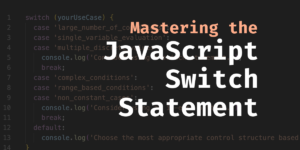Vanilla JavaScript

Learn how to create a sleep function in JavaScript for pausing code execution, given no built-in sleep() function for delaying program flow.

Learn how to successfully copy objects and their nested properties in JavaScript and avoid many common pitfalls

Learn how to merge any object in JavaScript with the spread ( ... ) operator, Object.assign() method, and JSON stringify and parse methods.

Master the switch statement: A more organized and concise alternative to using multiple if-else statements.

Learn what JavaScript callbacks are, how they work, their different types, how to create them, and how to employ them in your own code.

Learn how to avoid callback hell without ditching callbacks! By applying some SOLID principles, callbacks can still be a useful technique.

Learn how JavaScript promises work, how to create and chain them, how promise error handling works, and how to use recent promise methods.

The REST API is a key part of web infrastructure. Learn about REST and REST APIs, and how web apps communicate over HTTP like web browsers and servers do.

Follow this tutorial to build your own Wordle alternative for numbers in JavaScript: Numble.

In this guide, we will show you how you can learn to code with JavaScript for free. The JavaScript programming language is versatile, popular, and in high demand — making it a great language for learning how to code.

Learn when to use function expressions vs. function declarations in JavaScript, and how these methods for defining functions are different.

Learn how to use JavaScript arrow functions, understand fat and concise arrow syntax, and what to be aware of when using them in your code.

Higher-order functions can take other functions as arguments or return a function as a result. Learn how to use them and why they're useful.

Learn about for...in loops in JavaScript: their syntax, how they work, when to use them, when not to use them, and what you can use instead.

How does JavaScript's scoping system work? Learn the difference between local scope and global scope, and what hoisting is.

Yaphi Berhanu creates a JavaScript clock widget to demonstrate how coding your own components leads to more efficient code.

Yaphi and James walk you through making your own simple JavaScript quiz. This is a fun exercise and a great way to learn a variety of coding techniques.

Learn how to parse query string parameters and get their values in JavaScript. Use the results for tracking referrals, autocomplete, and more

Sort an array of objects in JavaScript dynamically. Learn how to use Array.prototype.sort() and a custom compare function, and avoid the need for a library.

Here's a quick tutorial to build a cipher machine using the JavaScript skills that are covered in my book, JavaScript: Novice to Ninja.

Thanks to transpilers, front-end applications are no longer limited to JavaScript. James Kolce looks at 10 different languages that compile to JavaScript.

Jeff Mott guides you through a step-by-step approach to JavaScript object creation — from object literals to factory functions and ES6 classes.

Samier Saeed walks you through the best way to implement a singleton in JavaScript and examines how that has evolved with the rise of ES6.

Ludovico Fischer introduces you to the Fetch API, a new standard that aims to unify fetching across the web and to replace XMLHttpRequest.

Moritz Kröger shows to use ES6 default parameters and property shorthands to help speed up development and write cleaner, clearer and more organized code.

Craig Buckler introduces ES6 modules, showing how they can be used today with the help of a transpiler.

Byron covers generators and iterators, two JavaScript features introduced in ES6 (ECMAScript 2015) that have changed the way developers write JavaScript.

Craig's latest tutorial explains how to use complex-sounding ES6 destructuring assignment shorthand syntax to simplify your code and save typing effort.

Aurelio introduces let and const, two new ES6 keywords for defining variables, showing examples of how they work and how they differ from the var keyword.

Aurelio introduces ES6 methods that work with arrays — Array.* and Array.prototype.* — showing examples of them in action and listing available polyfills.